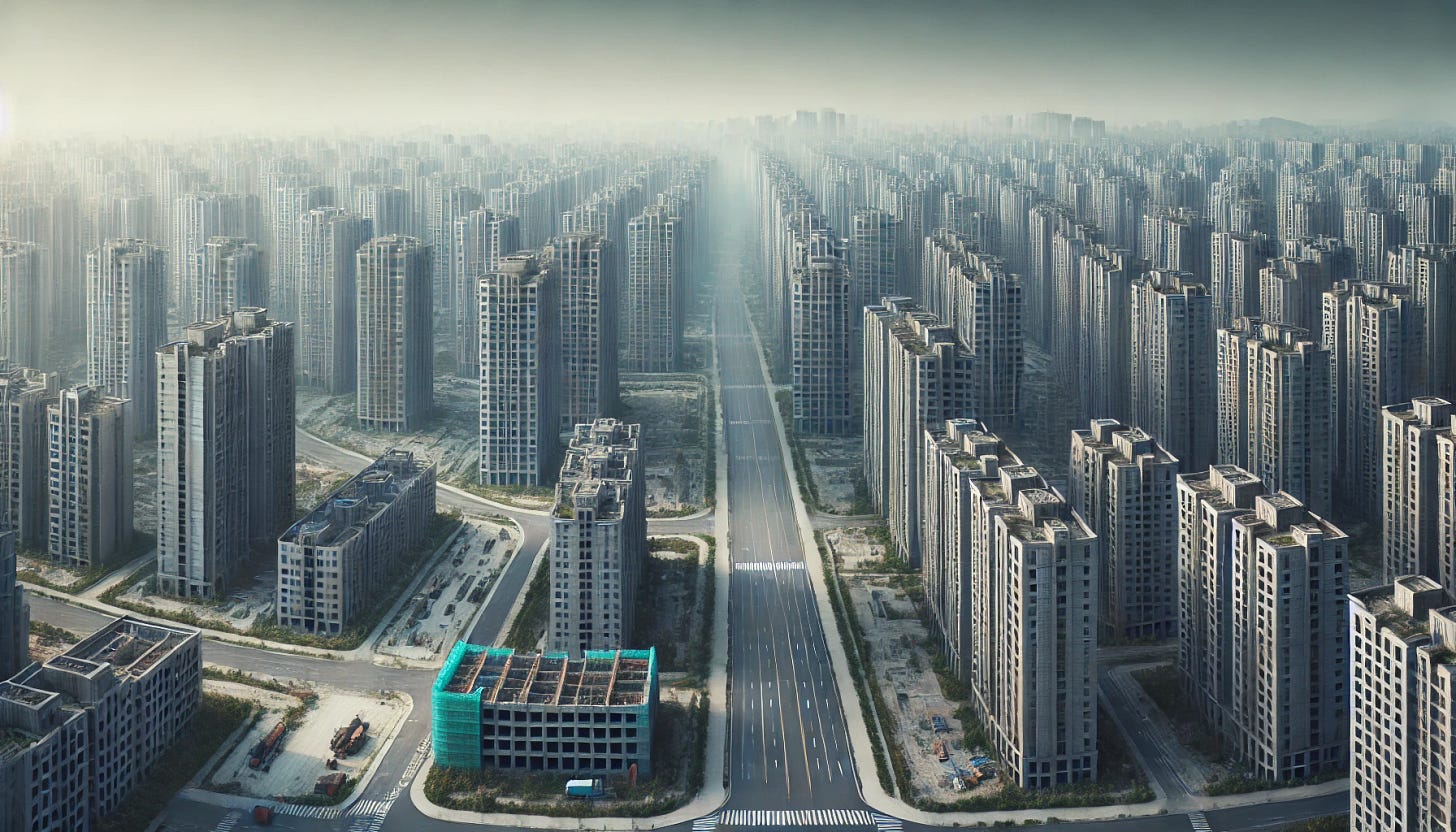#22: Shadows and Skylines of China’s Ghost Cities
Let’s delve into the evolution of these urban anomalies and their broader implications on China’s march toward modernization.
Let’s delve into the evolution of these urban anomalies and their broader implications on China’s march toward modernization.
Imagine sprawling urban landscapes with gleaming skyscrapers, meticulously planned residential complexes, and state-of-the-art infrastructure, yet eerily devoid of inhabitants.
This is the image often conjured when discussing China's "ghost cities," a phenomenon that has sparked global fascination, debate, and even mockery. And the country’s landscape hosts over 50 such ghost cities.
In this edition, we'll delve into the intricacies of this intriguing topic, tracing its historical roots, assessing its current state, and analyzing its global implications.
The Genesis: Early 2000s
Driven by a booming economy and a population moving from rural to urban regions faster than any country had seen before, the Chinese Government arrived at a key decision.
It was to invest in infrastructure and construct new urban areas, so that overpopulation, inflation and scarcity of resources in the existing cities could be controlled.
These were intended to lead to urbanization, stimulate economic growth, and redistribute populations from congested megacities.
And the plan worked out beautifully, with urbanisation soaring from 36% in 2000 to 50% in 2010!
..
The 2008 Financial Crisis.
However, in that journey, around 2008, things went awry.
Following the global financial crisis, in a bid to stimulate the economy, the Chinese Government decided to double down on its approach to building new urban areas.
Given construction as a sector delivers a high multiplier effect, the Government wanted to take this route to stimulate the economy across sectors.
And in sync with this, the local governments, eager to propel economic growth and attract investment, embarked on ambitious urban expansion projects.
And this is where the problem took birth.
What problem?
The construction sector exploded, fueled by local governments' revenue reliance on land sales and an investment-driven GDP model.
Cities like Ordos in Inner Mongolia and Tianducheng, with its replica Eiffel Tower, became internationally famous symbols of China's overreach in urban planning. In fact, China is estimated to have built more cities in the past few decades than Europe has in its entire history.
However, development in many of these cities began to outpace the actual demand for housing and commercial spaces, leading to the creation of vast, underpopulated urban areas.
Hence, followed a surplus of housing and commercial properties. In fact, as per a 2023 report by the National Bureau of Statistics, there were over 65 million vacant apartments in China, enough to house the entire population of France.
This oversupply began driving down property prices, driving up the debt levels for developers, and impacting the long-term sustainability of China's real estate market.
But, there is a sunny side too.
As of 2023, the narrative around ghost cities has shifted somewhat.
Many of the ghost cities thus built have since grown to attract sizeable populations, delivering some respite to the policy makers, local Governments and developers.
Some of these cities, like Zhengdong New District in Zhengzhou, have begun to fill up thanks to improved connectivity to more established urban centres.
And there are many more such cases, as can be understood from the table below.
However, others remain underpopulated, serving as stark reminders of the risks of overzealous development.
..
Analyzing the Drivers and Consequences
The emergence of ghost cities is a complex issue with multiple contributing factors.
Local governments, incentivized by performance metrics tied to economic growth and investment attraction, often prioritized large-scale construction projects over more sustainable and demand-driven development.
This led to a disconnect between supply and demand, resulting in vacant properties and underutilized infrastructure.
Furthermore, the speculative nature of China's real estate market exacerbated the problem. Investors, both domestic and foreign, fueled a property bubble, driving up prices and encouraging further construction.
However, when the bubble began to deflate, many investors were left with unsold properties, contributing to the ghost city phenomenon.
And then there is the obvious environmental impact, with vast amounts of resources wasted on the construction and maintenance of vacant properties.
The economic implications are also substantial, as these empty cities represent a drag on economic growth and a potential source of financial instability.
Additionally, the social impact cannot be ignored, as ghost cities can create feelings of isolation and alienation among residents, leading to social problems.
Global Echoes: Lessons for the World
China's experience with ghost cities offers valuable lessons for other countries undergoing rapid urbanization.
It highlights the importance of balanced and sustainable development, taking into account the actual needs of the population and the environment.
It also underscores the need for prudent financial management and regulation of the real estate sector to prevent speculative bubbles and overbuilding.
Countries like India, which is currently experiencing a period of rapid urbanization, can learn from China's mistakes and adopt a more calculated approach to urban development, where money is deployed in and around regions and segments where the likeliness of demand holding up is higher.
Turning the Tide: Recent Developments and Policy Shifts
Coming back to China, in recent years, the Chinese government has acknowledged the issue of ghost cities and has taken steps to address it.
The central government has issued directives to local governments to prioritize the renovation of existing urban areas over new construction. It has also tightened regulations on the real estate sector, curbing speculative investment and promoting more sustainable development practices.
Additionally, the government has launched initiatives to attract residents, businesses and industries to ghost cities, offering incentives like affordable housing, tax breaks, and job opportunities.
These efforts are starting to bear fruit, with some ghost cities showing signs of revitalization as more people move in and businesses set up shop.
The only question is, how long will it take?
Conclusion: A Paradigm Shift in Urban Development
China's ghost cities are a complex and multifaceted issue with no easy solutions.
They highlight critical issues such as asset bubbles, inefficient capital allocation, and the socioeconomic risks of mismatched urban planning.
They are a reminder of the challenges and risks associated with rapid urbanization. Yet, they also offer unique opportunities for studying urban development, and eventually, they could serve as templates for future smart cities once demand catches up.
Stay tuned for more insights as I continue to explore the transformative journeys within China's dynamic sectors.








Really enjoyed it, going throught the series but want same series with opportunity in India. Which could be more great .
Informative, Thanks Jayant Sir